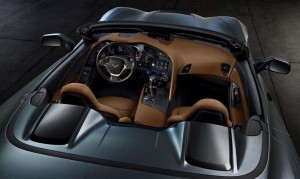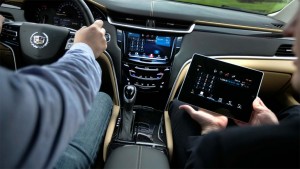
GM made the interior of the 2014 Corvette Stingray one of its highest priorities in the development of the new C7.
If you haven’t bought a car in recent years, you may be in for a surprise to discover the way the demands for greater fuel-efficiency, connectivity and fashion are transforming vehicle interiors.
“There is a coolness factor involved,” Johann Jungwirth, president and chief executive officer of Mercedes-Benz research and Development in Silicon Valley. “The basic ability to connect digitally is important,” particularly for younger consumers not only in the U.S. but in Europe and China, which has spawned a major research effort on the part of Mercedes.
The ultimate goal is to find apps that enhance the driver’s needs without compromising safety, Jungwirth told the Wards Auto Interiors Conference.
Mike VanNieuwkyuk, executive director of global vehicle research at J.D. Power & Associates, noted motorists now spend more time in their cars but are also being pressed to use the smart phone technology to be more productive while they are commuting. Consumers want the same access to connected technology in their vehicles they have in the home or office.

While traditional interior details, like leather and wood, remain important, motorists also want high-tech interiors that deliver the sort of features found on an iPad.
They also demand improved materials like leather, wood and chrome, and more safety features which, in some vehicles can mean as many as a dozen different airbags. It all adds up to a lot of mass at the same time carmakers and suppliers are facing pressure to reduce the vehicle weight as part of the effort to meet rising fuel economy targets set by the government.
The key is rebuilding the structures of the interior, which accounts for more than one third of the car by eliminating obsolete pieces such as door locks and combining separate pieces into one structure, said Bryan Nyeholt, senior vice president of innovation at Johnson Controls, a major supplier of seats and other interior components.
“I tell my guys to concentrate on homeruns. We don’t need bunts and singles. Continuous improvement will come,” he said.
Vehicle interiors have already undergone a substantial change over the past five years as automakers have attempted to appease increasingly demanding customers, noted Gerard Roose, vice president of sales and marketing for Inteva, a supplier of materials and designs used in vehicle interiors,
Roose noted, during a panel discussion, that changes inside the car over the past five years have been dramatic, he said. Features, such as soft-touch material and leather surfaces, once found only luxury vehicles a few years ago, are now becoming standard in mid-level and even entry-level cars, Roose said.
Hard plastic, a dominant feature on the inside of less expensive models, have been banished from much of the center stack, he said.
“You have to know how to design,” explained Roose. “Designing is about using the right materials,” he added, noting that cars today also have to serve as living rooms and mobile offices.
Karl Henn, director of seating development for mega-supplier Lear, noted that from the instant when the doors swings open, interiors shape consumer perceptions of a vehicle.
“Seats have a big role in shaping the impression the car creates,” he said. “The design of the seats in a Ferrari, which Lear makes for the Italian carmaker, conveys a sense of high fashion, functionality and comfort in one package. Smaller, lower seats also can help improve a vehicle’s aerodynamic characteristics.”
Amko Leenarts, global director of interior design for the Ford Motor Co., said one of the keys he emphasizes is that successful designs of all kinds have a solid emotional appeal.
“The objects have to have soul,” added Leenarts, noting designers of consumer goods now spend time designing in flaws to give their products character or soul.
“We also want objects that are smart,” said Leenarts, who spent a dozen years at the French automaker Peugot before joining Ford Motor Co. He also suggested cars of the future will require a lot of room for personalization and more color and as well as what he described as “textual simulation” to help motorists manage the driving task.
“Text messaging has changed the way we communicate with each other,” he noted. “So vehicles must incorporate some of the new iconography that goes along with smart phones and texting,” he noted, suggesting, “Everything is possible today.”
For the Cadillac XTS, General Motors designers borrowed from the fashion business by studying how that industry chooses leathers for handbags and shoes to help them design the interior for the XTS sedan in a way that would be an extension of products familiar to affluent consumers.
“As automotive designers we can draw parallels, especially from luxury fashion, in the way materials like leather are selected and treated,” said Erin Crossley, a design manager who helped style the XTS’s interior. “We applied small details, such as stitching touches, from fashion to deliver a refined interior with finishes that a customer can appreciate for its attention to detail.”

I hope when these people who are “connected digitally” crash their car, that the lawyers start suing the car makers for adding all of the driver distractions that account for a significant amount of inattentive driving. It’s total insanity and completely irresponsible to install this stuff anywhere near the driver.
However, it is the driver’s CHOICE to not only buy a vehicle with the distractions installed, but also to use the distractions while driving.